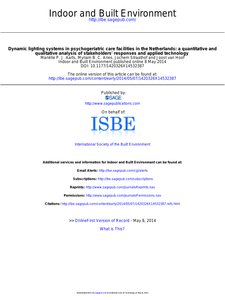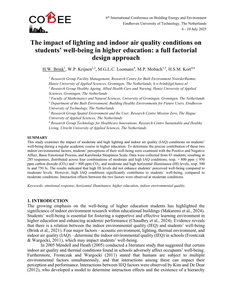Light enables us to see and perceive our environment but it also initiates effects beyond vision, such as alertness. Literature describes that at least six factors are relevant for initiating effects beyond vision. The exact relationship between these factors and alertness is not yet fully understood. In the current field study, personal lighting conditions of 62 Dutch office workers (aged 49.7 ± 11.4 years) were continuously measured and simultaneously self-reported activities and locations during the day were gathered via diaries. Each office worker participated 10 working days in spring 2017. Personal lighting conditions were interpreted based on four of the six factors (light quantity, spectrum, timing, and duration of light exposure). Large individual differences were found for the daily luminous exposures, illuminances, correlated colour temperatures, and irradiances measured with the blue sensor area of the dosimeter. The average illuminance (over all participants and all days) over the course of the day peaked three times. The analysis of the duration of light exposure demonstrated that the participants were on average only exposed to an illuminance above 1000 lx for 72 minutes per day. The interpretation of personal lighting conditions based on the four factors provides essential information since all of these factors may be relevant for initiating effects beyond vision. The findings in the current paper give first in-depth insight in the possibilities to interpret personal lighting conditions of office workers.
MULTIFILE

Journal of Physics: Conference Series Paper • The following article is Open access Exploring the relationship between light and subjective alertness using personal lighting conditions J. van Duijnhoven1, M.P.J. Aarts1, E.R. van den Heuvel2 and H.S.M. Kort3,4 Published under licence by IOP Publishing Ltd Journal of Physics: Conference Series, Volume 2042, CISBAT 2021 Carbon-neutral cities - energy efficiency and renewables in the digital era 8-10 September 2021, EPFL Lausanne, Switzerland Citation J. van Duijnhoven et al 2021 J. Phys.: Conf. Ser. 2042 012119 Download Article PDF References Download PDF 29 Total downloads Turn on MathJax Share this article Share this content via email Share on Facebook (opens new window) Share on Twitter (opens new window) Share on Mendeley (opens new window) Hide article information Author e-mails j.v.duijnhoven1@tue.nl Author affiliations 1 Building Lighting Group, Department of the Built Environment, Eindhoven University of Technology, Eindhoven, The Netherlands 2 Stochastics, Department of Mathematics and Computer Science, Eindhoven University of Technology, Eindhoven, The Netherlands 3 Research Centre Healthy and Sustainable Living, University of Applied Sciences Utrecht, Utrecht, The Netherlands 4 Building Healthy Environments for Future Users Group, Department of the Built Environment, Eindhoven University of Technology, Eindhoven, The Netherlands DOI https://doi.org/10.1088/1742-6596/2042/1/012119 Buy this article in print Journal RSS Sign up for new issue notifications Create citation alert Abstract The discovery of the ipRGCs was thought to fully explain the mechanism behind the relationship between light and effects beyond vision such as alertness. However, this relationship turned out to be more complicated. The current paper describes, by using personal lighting conditions in a field study, further exploration of the relationship between light and subjective alertness during daytime. Findings show that this relationship is highly dependent on the individual. Although nearly all dose-response curves between personal lighting conditions and subjective alertness determined in this study turned out to be not significant, the results may be of high importance in the exploration of the exact relationship.
MULTIFILE

Health symptoms may be influenced, supported, or even controlled via a lighting control system which includes personal lighting conditions and personal factors (health characteristics). In order to be effective, this lighting control system requires both continuous information on the lighting and health conditions at the individual level. A new practical method to determine these continuous personal lighting conditions has been developed: location-bound estimations (LBE). This method was validated in the field in two case studies; comparisons were made between the LBE and location-bound measurements (LBM) in case study 1 and between the LBE and person-bound measurements (PBM) in case study 2. Overall, the relative deviation between the LBE and LBM was less than 15%, whereas the relative deviation between the LBE and PBM was 32.9% in the best-case situation. The relative deviation depends on inaccuracies in both methods (i.e., LBE and PBM) and needs further research. Adding more input parameters to the predictive model (LBE) will improve the accuracy of the LBE. The proposed first approach of the LBE is not without limitations; however, it is expected that this practical method will be a pragmatic approach of inserting personal lighting conditions into lighting control systems.
DOCUMENT

Lighting in video games is used to set moods and atmosphere, or can serve as a gameplay tool. This paper examines the effects lighting concepts can have on a virtual game environment on the players’ navigation within the game. Previously known lighting concepts were tested in a virtual environment to determine if they have a similar effect on the perception of the presented virtual space as they do in real life, as well as the effect they have on the navigational behavior of players. In a game-experiment with 50 male participants we show that the previously known lighting concepts apply to the virtual environment in a similar manner as they do in real life, although the effects on the navigational behavior of the participants remain inconclusive.
DOCUMENT
Lighting accounts for a significant amount of electrical energy consumption in office buildings, up to 45% of the total consumed. This energy consumption can be reduced by as much as 60% through an occupant-dependent lighting control strategy. With particular focus on open-plan offices, where the application of this strategy is more challenging to apply due to differences in individual occupancy patterns, this paper covers (1) to which extent individual occupancy-based lighting control has been tested, (2) developed, and (3) evaluated. Search terms were defined with use of three categories, namely ‘occupancy patterns’, ‘lighting control strategy’, and ‘office’. Relevant articles were selected by a structured search through key online scientific databases and journals. The 24 studies identified as eligible were evaluated on six criteria: (1) study characteristics, (2) office characteristics, (3) lighting system characteristics, (4) lighting control design, (5) post-occupancy evaluation, and (6) conclusions, and this was used to answer the research questions. It was concluded that the strategy has not been tested yet with field studies in open-plan offices, but that it needs further development before it can be applied in these type of offices. Although lighting currently tends to be controlled at workspace level, many aspects of the strategy can be further developed; there is potential to further increase energy savings on lighting within open-plan office spaces. Individual occupancy-based lighting control requires further validation, focussing on the factors influencing its energy savings, on its cost effectiveness, and on its acceptability for users.
DOCUMENT

Long-term care facilities are currently installing dynamic lighting systems with the aim to improve the well-being and behaviour of residents with dementia. The aim of this study was to investigate the implementation of dynamic lighting systems from the perspective of stakeholders and the performance of the technology. Therefore, a questionnaire survey was conducted with the management and care professionals of six care facilities. Moreover, light measurements were conducted in order to describe the exposure of residents to lighting. The results showed that the main reason for purchasing dynamic lighting systems lied in the assumption that the well-being and day/night rhythmicity of residents could be improved. The majority of care professionals were not aware of the reasons why dynamic lighting systems were installed. Despite positive subjective ratings of the dynamic lighting systems, no data were collected by the organizations to evaluate the effectiveness of the lighting. Although the care professionals stated that they did not see any large positive effects of the dynamic lighting systems on the residents and their own work situation, the majority appreciated the dynamic lighting systems more than the old situation. The light values measured in the care facilities did not exceed the minimum threshold values reported in the literature. Therefore, it seems illogical that the dynamic lighting systems installed in the researched care facilities will have any positive health effects.
DOCUMENT

This study examines the impact of moderate and high lighting and indoor air quality (IAQ) conditions on students’ well-being during a regular academic course in higher education. To determine the precise contribution of these two indoor environmental factors, students’ perceptions of their well-being were examined with the Positive and Negative Affect, Basic Emotional Process, and Karolinska Sleepiness Scale. Data were collected from 83 students, resulting in 285 responses, distributed across four combinations of moderate and high IAQ conditions, resp. > 800 ppm ≤ 950 ppm carbon dioxide (CO2) and < 800 ppm CO2, and moderate and high horizontal illuminance (HI) levels, resp. 500 lx and 750 lx. The results indicated that high HI levels did not enhance students’ perceived well-being compared to moderate levels. However, high IAQ conditions significantly contributes to students’ well-being, compared to moderate conditions. Interaction effects between the two factors were observed at moderate conditions.
DOCUMENT

Daylight has been associated with multiple health advantages. Some of these claims are associations, hypotheses or beliefs. This review presents an overview of a scientific literature search on the proven effects of daylight exposure on human health. Studies were identified with a search strategy across two main databases. Additionally, a search was performed based on specific health effects. The results are diverse and either physiological or psychological. A rather limited statistically significant and well-documented scientific proof for the association between daylight and its potential health consequences was found. However, the search based on specific health terms made it possible to create a first subdivision of associations with daylight, leading to the first practical implementations for building design.
DOCUMENT
